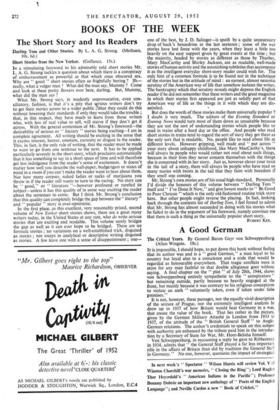BOOKS OF THE WEEK
The Short Story and Its Readers
Darling Tom and Other Stories. By L. A. G. Strong. (Methuen. 10s. 6d.) Short Stories from the New Yorker. (Gollancz. 15s.) In a stimulating foreword to his admirably told short stories Mr. L. A. G. Strong tackles a question about which there is a conspiracy of embarrassment as powerful as that which once obscured sex. Why are " good " short stories often so frightfully boring ? Sh- really, what a vulgar man ! What did the man say, Mummy ? Come and look at these pretty flowers over here, darling. But, Mummy, what did the man say ?
What Mr. Strong says, in modestly unprovocative, even con- ciliatory, fashion, is that it's a pity that serious writers don't try to get their stories across to a wider public Nhat they could do this without lowering their standards if only they would take the trouble ; that, in this respect, they have much to learn from those writers who, with less of real value to sell, will starve if they don't get it across. With the general contention of Mr. Strong's foreword—the desirability of serious or " literary " stories being exciting—I am in complete agreement. All writing should be exciting in the sense that it excites interest, horror, emotion, curiosity or disgust in the reader. This, in fact, is the only rule of writing, that the reader must be made to want to go from one sentence to the next. It has to be applied particularly severely in the short story, which proclaims automatically that it has something to say in a short space of time and will therefore get less indulgence from the reader's sense of excitement. It doesn't matter how well you describe the wall-paper, budgerigars or states of mind in a room if you can't make the reader want to hear about them. Nor how many corpses, naked ladies or sacks of marijuana you throw in if the reader still wants to turn to the racing. No story can be " good," or " literature "—however profound or rarefied its subject—unless it has this quality of in some way exciting the reader about the sentences to come. But I think Mr. Strong's conclusion that this quality can completely bridge the gap between the" literary" and " popular " story is over-optimistic. In the first place, as this excellent, very reasonably priced, second volume of New Yorker short stories shows, there are a great many writers today, in the United States at any rate, who do write serious stories that are exciting and readable. This volume surely bridges the gap as well as it can ever hope to be bridged. These are no formula stories ; no variations on a well-established trick, disguised as stories ; nor essays in analytical or descriptive writing disguised as stories. A few leave one with a sense of disappointment ; one— one of the best, by J. D. Salinger—is spoilt by a quite unnecessary drop of hack's benzedrine in the last sentence ; some of the war stories have lost force with the years, when they leant a little too heavily on the easy support given by great events at the time ; but the majority, headed by stories as different as those by Thurber, Mary MacCarthy and Shirley Jackson, are as readable, well-made stories of human activity and the astonishing subtleties that accompany it as the intelligent everyday short-story reader could wish for. The only hint of a common formula is to be found not in the technique of the stories but in the attitude of mind : an earnest, almost neurotic scrutiny of the American way of life that somehow isolates the writer. The bankruptcy which that scrutiny reveals might depress the English reader if he did not remember that these writers and the great magazine in which their stories first appeared are just as solidly part of that American way of life as the things in it with which they are dis- satisfied.
But does the worth of these stories make them universally popular ? I doubt it very much. The editors of the Evening Standard or Evening News would turn most of them down as unsuitable because they are not the sort of undemanding stories which people like to read in trains after a hard day at the office. And people who read short stories in trains tend to regard the sort of story they get there as the only sort that is readable. No, people like to read about life at different levels. However gripping, well made and " put across " your story about unhappy childhood, like Mary MacCarthy's, there will always be people who would rather not read about such things, because in their lives they never concern themselves with the things she is concerned with in her story. Just as, however clever your twist in the tail of a story, there will always be people who have read so many stories with twists in the tail that they faint with boredom if they smell one coming.
Mr. Strong's own stories are of his usual high standard. Personally I'd divide the honours of this volume between " Darling Tom " itself and " I've Done It Now," and give lowest marks to " Be Good to Poor Chrissie " which is the only old-fashioned routine trick story here. But other people might reverse the placing. In fact, looking back through the contents list of Darling Tom, I feel forced to admit that Mr. Strong has almost succeeded in doing with his stories what he failed to do in the argument of his foreword, namely convince me that there is such a thing as the universally popular short story.
ROBERT KEE.


































 Previous page
Previous page